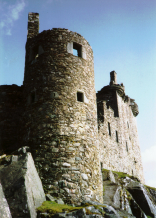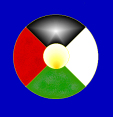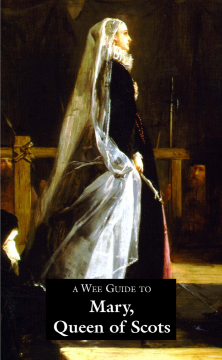Mary Queen of Scots: Love and Marriage
The exiled Earl of Lennox appealed to Mary to be allowed to return to Scotland. When she agreed to this she upset several of her loyal Protestant nobles, not least
Châtelherault and the rest of the Hamiltons, as the Lennoxes had a shared dynastic claim to the throne with the Hamiltons. Equally upsetting was the fact that he was a Catholic; but it was his son
Henry, Lord Darnley, who would prove to have a devastating effect on Mary and her future. Darnley was brought up by his mother, Lady Margaret Douglas, to be a fine sportsman, well versed in courtly
refinements and expected by his mother to be a possible suitor first for Elizabeth, and later Mary. Darnley was tall and good looking and when Elizabeth saw him at court, she took quickly to the idea
of Darnley as Mary’s suitor instead of Dudley.
Darnley arrived in Scotland in the beginning of 1565 and Mary first met him at Wemyss Castle on 16 February during another of her progresses. This journey between 16 January and 24
February 1565 included Falkland, the Balfour Castle at Collairnie near Cupar, Ballinbreich Castle, owned by the Leslies, near Newburgh, Balmerino Abbey and St Andrews. She then travelled to
Struthers, a property owned by the Lindsays of The Byres, followed by Lundin Tower near Lower Largo and Durie, and finally to Wemyss Castle. Before returning to Edinburgh Mary called at Dunfermline,
staying at the abbey there. Initially relations between Mary and Darnley were very much those of monarch and subject, and
Darnley was extremely courteous and respectful, which pleased Mary. After a visit to Dunkeld, to visit his father, he re-joined the Queen as she returned to Edinburgh and became a constant member of
the royal court.
Darnley made every effort to charm Mary by dancing and singing, and generally participating in all the courtly pursuits which Mary so enjoyed. Darnley and David Rizzio got on very
well together, which pleased Mary, and Darnley also shared Mary’s enjoyment of hunting. It is not clear if Mary was already planning to marry Darnley, but when Elizabeth suddenly announced that if
Mary was to marry Dudley she would lose her claim to the English throne, Mary was very upset and felt that she had been used by Elizabeth. Whatever her motives, she turned her attention to Darnley as
a possible suitor.
This plan certainly ruffled many feathers. Mary may have believed that a marriage to Darnley would strengthen her claim to the English throne, and indeed privately Elizabeth may
have seen it as a better alternative than marriage to a continental Catholic, but this was not her reported public reaction. Nor did Mary’s nobles feel that this was a wise move, and after she spent
some time nursing Darnley through a bout of measles in April 1565, some of her most loyal Protestant nobles – Moray, Lord James, Châtelherault, Glencairn, Morton and Ruthven, signed a bond agreeing
to join together to prevent the marriage. The motives behind the signing of this bond may have had as much to do with dislike of Lennox, and fear of his possible increase in power, as the
unsuitability of the marriage.
By May, Moray made his opinion about the match obvious to Mary, and Argyll refused to attend the convention which discussed, and eventually agreed to, Mary’s wishes. Later that
month, Mary created Darnley Earl of Ross; Lord Robert Stewart was created Earl of Orkney and Shetland, and in June, Lord Erskine was raised to the earldom of Mar. It might be said that with the loss
of some of her most senior nobles, Mary was attempting to create a second line of defence.
Mary issued a proclamation in July, in reply to a supplication from her subjects, and declared that she did not intend to interfere with matters of religion; and at the same time
she requested a papal dispensation from Rome to permit the marriage to Darnley. This was because she and Darnley were, as blood relatives, and according to church rules, too closely related. In the
end, Mary did not wait until the dispensation arrived and rumours abounded that this was because she was already Darnley’s mistress. Society has always indulged in gossip about the rich and famous,
and sixteenth-century Scotland was no exception. Even ministers of the church, especially Knox, thought fit to comment on the rumours about Mary’s sex life.
Once Mary had received tacit agreement from her French relatives, Philip of Spain and Charles IX of France, she could wait no longer and on 16 July Mary and Darnley rode to
Seton Palace, stronghold of Lord Seton, a Catholic supporter of Mary. The couple stayed two nights there, adding to the public rumours, before they returned to Edinburgh. The following Sunday, the
banns, or proclamations, were announced for their forthcoming wedding, which was to take place on 19 July 1565. During the intervening days, Mary made it clear that the opposition to her choice of
husband displeased her greatly. There were rumours that Darnley had plotted against Moray, but Moray had actually started these rumours himself. Mary could see no obstacle to the wedding, and even
the question of Darnley’s religion was not an issue. Darnley, although his mother was Catholic, had professed the reformed faith in England, so he did not attend the wedding Mass and attended
services at St Giles led by Knox.
Early in the morning of Sunday 29 July, Mary, dressed in black as a sign of her widowhood, was escorted from her chambers at Holyrood Palace to the private chapel. As part of
the ceremony, Darnley placed three rings on Mary’s finger, after which they were blessed by the priest. Darnley then left his bride to her private Mass. On her return to her apartments, her
attendants removed her black widow’s dress which they replaced with a new brightly-coloured gown, symbolizing a new stage in her life. The wedding celebrations, although perhaps not as sumptuous as
those she had experienced in France, were merry and lavish. Eating, drinking, music and dancing were enjoyed by the guests, and handfuls of gold coins were thrown to the watching crowds.
Before her marriage Mary had declared that Darnley was to be referred to as King of Scots, a title which she was not legally entitled to grant, and which added to the nobles’
displeasure with Darnley. When Moray, summoned to appear before her to explain his behaviour, failed to appear Mary declared him ‘put to the horn’, and officially declared outlaw. This was the start
of what was to be known as the Chaseabout Raid.
Moray and the other rebels made for Argyll, and Mary announced that any who provided them with aid would be punished. The rebels appealed to Elizabeth for assistance, using the
ready excuse of the reformed religion as a common cause, as well as stressing the dangers associated with Darnley’s recent promotion. Whether Mary had found new confidence with her recent marriage,
or whether she was actually fearful that the Protestant rebels might succeed is not clear but she responded quickly during this crisis. She made it clear that she was not willing to lose all that she
had so recently gained, and, summoning her troops, she set out to quash the rebellion. Mary also ordered Edinburgh town council to depose its Protestant provost and she replaced him with Sir Simon
Preston of Craigmillar, who was to prove one of her most loyal supporters in later years.
Mary headed towards Stirling as the rebels – Châtelherault and Moray and approximately 2000 men – arrived in Edinburgh, but they found little support there and so made for the
south-west and Dumfries, hoping that Elizabeth might have sent help north. Mary, after a visit to the Ruthven castle, later called Huntingtower, near Perth, returned to Edinburgh by 22 September
where she hoped to raise more support. Having put Châtelherault and the others, as well as Moray, to the horn, Mary followed them to Dumfries, ready to resolve the situation by combat if required. By
the 8 October, Mary and her forces had arrived at Dumfries, from where she and Darnley attended a banquet at Lochmaben Castle on 14 October, but Moray had already crossed the border
once he realized that there was to be no English help. Indeed, Elizabeth later even refused to grant any of the rebels an audience. It was at Dumfries that Mary met another man, who was later to be
an important influence on her. The Earl of Bothwell had recently returned from exile, and Mary made him her lieutenant-general when he joined her campaign.
The Chaseabout Raid may not have been an auspicious start to a new marriage, but it showed Mary at her most effective and regal – able to respond as the situation demanded, and
also able to command a good amount of popular support from the ordinary people of Scotland. The marriage to Darnley may have made some Scots unhappy, but it appeared that the majority supported her,
which would have reassured her. Mary returned to Edinburgh and set about the business of governing her kingdom with, she hoped, the support of her husband. The peers of the realm who were now Mary’s
supporters were Huntly, Atholl, Lennox and Bothwell; other posts were filled with non-Scots or others not of noble birth. Nevertheless Mary hoped that things would soon settle down. However, it
became obvious quite quickly that Darnley was unsuited for his responsibilities, either because he was too young or because he was not interested. Instead of being a help to Mary, he began to be a
hindrance.
© Joyce Miller & Martin Coventry 2018









